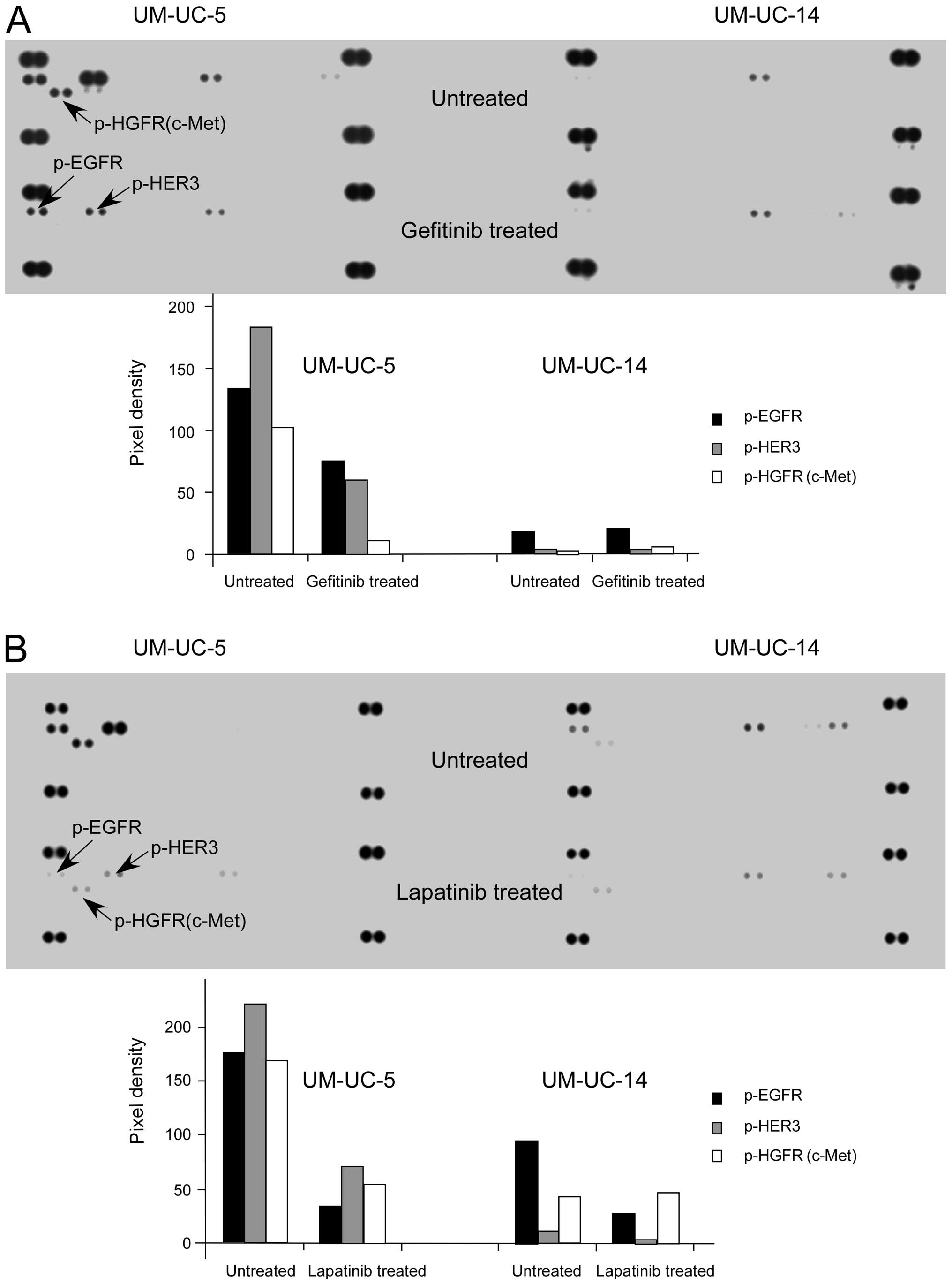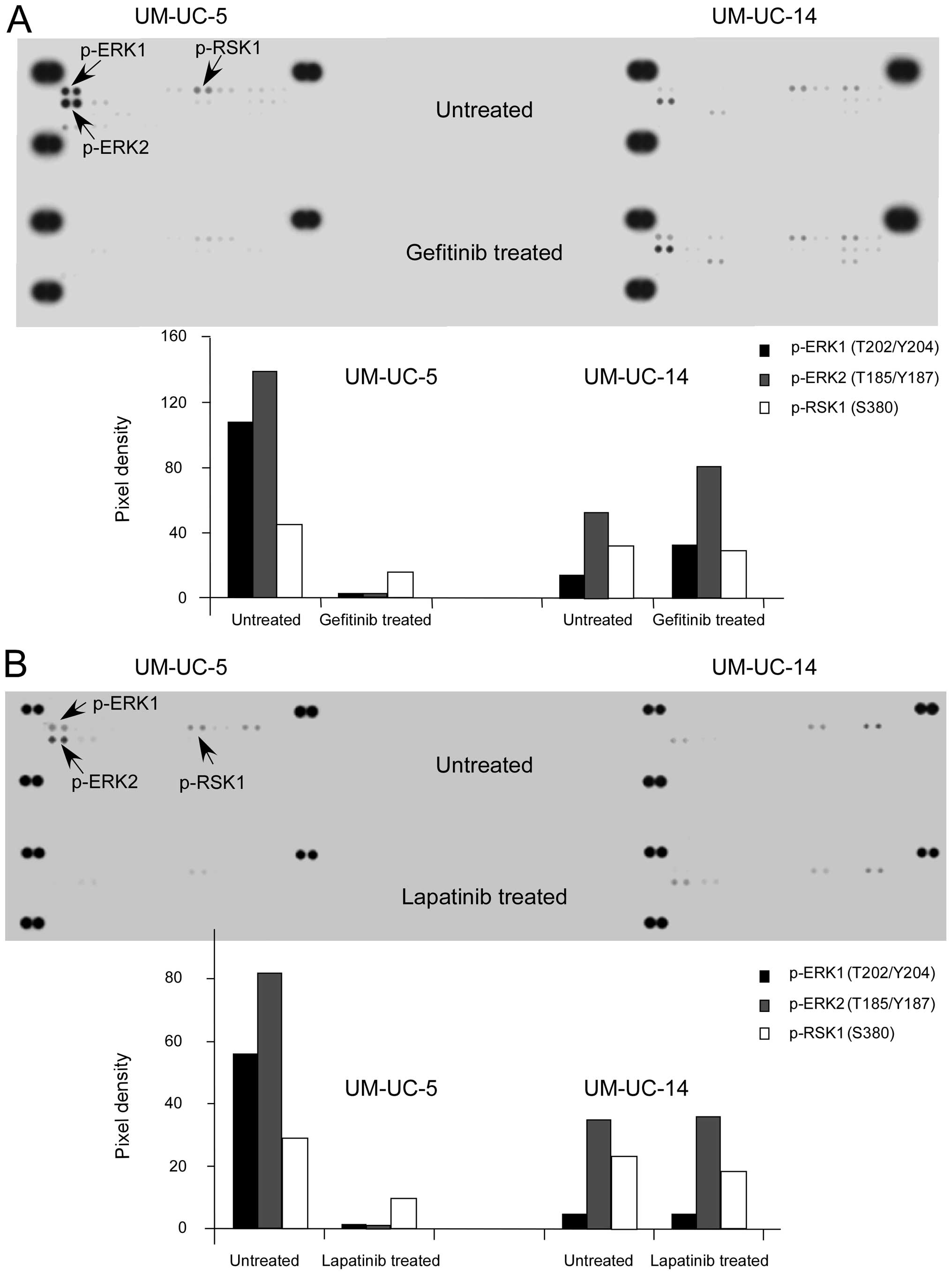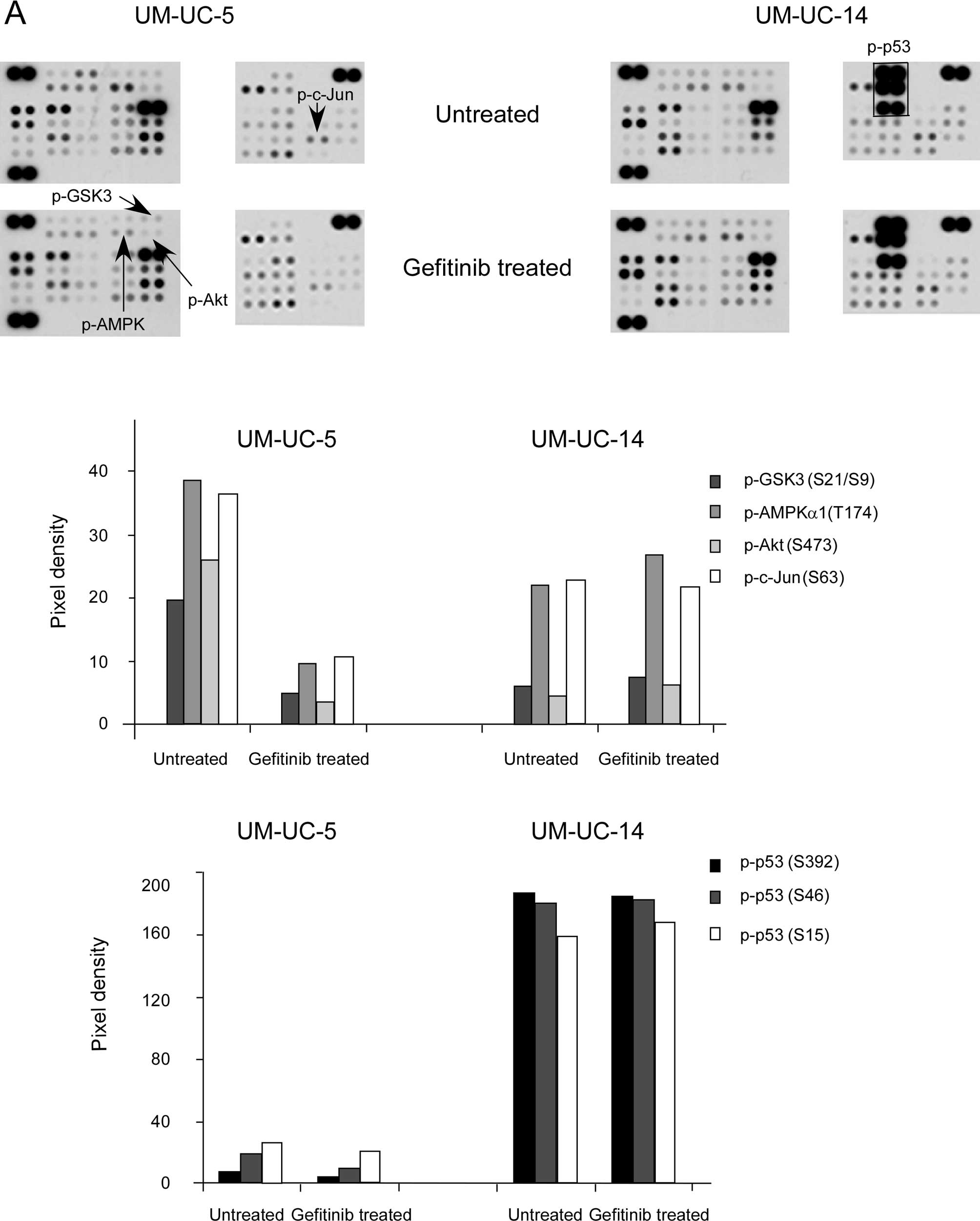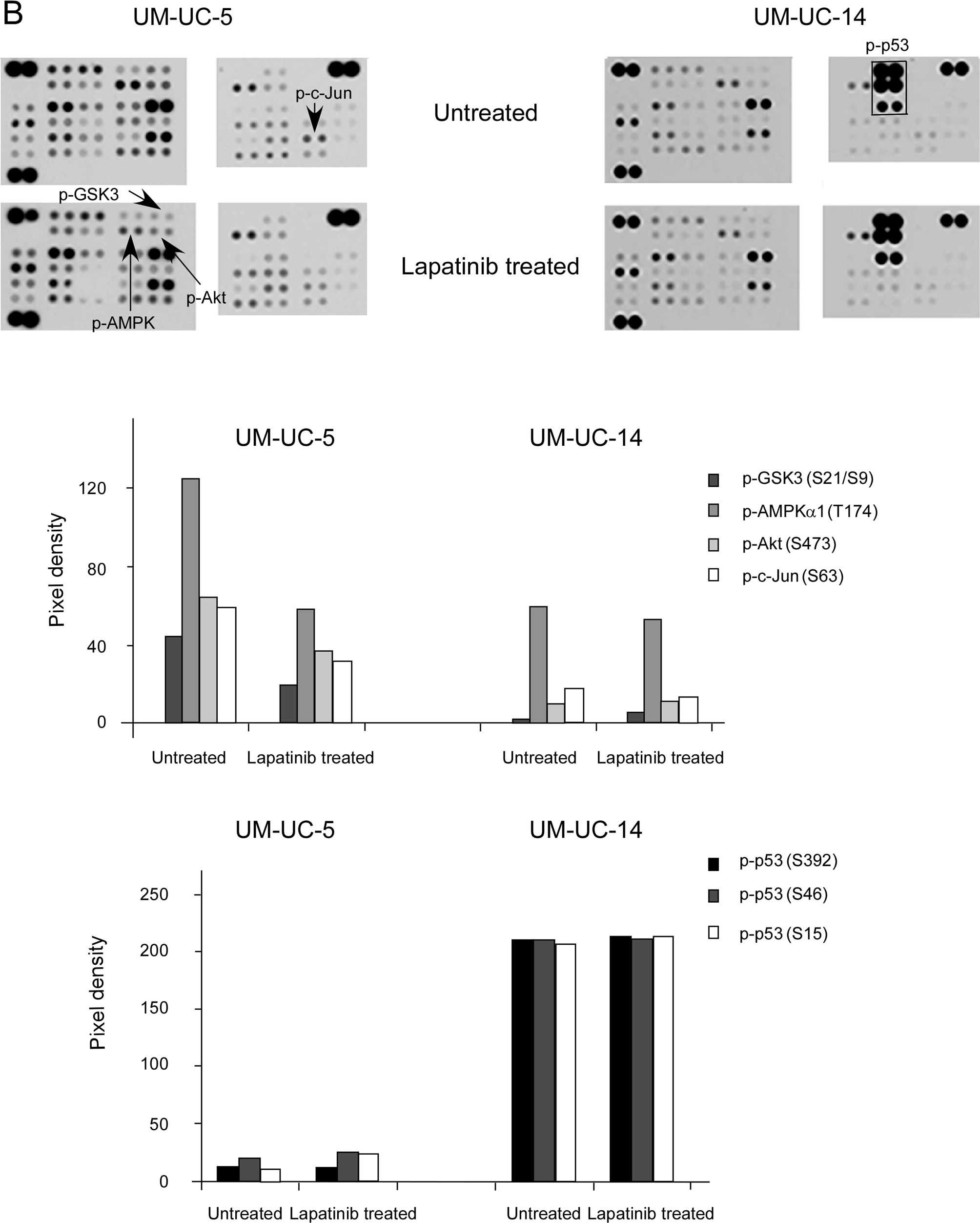|
1
|
van Rhijn BW, Burger M, Lotan Y, et al:
Recurrence and progression of disease in non-muscle-invasive
bladder cancer: from epidemiology to treatment strategy. Eur Urol.
56:430–442. 2009. View Article : Google Scholar : PubMed/NCBI
|
|
2
|
McHugh LA, Sayan AE, Mejlvang J, et al:
Lapatinib, a dual inhibitor of ErbB-1/-2 receptors, enhances
effects of combination chemotherapy in bladder cancer cells. Int J
Oncol. 34:1155–1163. 2009.PubMed/NCBI
|
|
3
|
Wang X, Zhang S, MacLennan GT, et al:
Epidermal growth factor receptor protein expression and gene
amplification in small cell carcinoma of the urinary bladder. Clin
Cancer Res. 13:953–957. 2007. View Article : Google Scholar : PubMed/NCBI
|
|
4
|
Shrader M, Pino MS, Brown G, et al:
Molecular correlates of gefitinib responsiveness in human bladder
cancer cells. Mol Cancer Ther. 6:277–285. 2007. View Article : Google Scholar : PubMed/NCBI
|
|
5
|
Johnson LN: Protein kinase inhibitors:
contributions from structure to clinical compounds. Q Rev Biophys.
42:1–40. 2009. View Article : Google Scholar : PubMed/NCBI
|
|
6
|
McHugh LA, Kriajevska M, Mellon JK and
Griffiths TR: Combined treatment of bladder cancer cell lines with
lapatinib and varying chemotherapy regimens - evidence of
schedule-dependent synergy. Urology. 69:390–394. 2007. View Article : Google Scholar : PubMed/NCBI
|
|
7
|
Shrader M1, Pino MS, Lashinger L, et al:
Gefitinib reverses TRAIL resistance in human bladder cancer cell
lines via inhibition of AKT-mediated X-linked inhibitor of
apoptosis protein expression. Cancer Res. 67:1430–1435. 2007.
View Article : Google Scholar : PubMed/NCBI
|
|
8
|
Dancey JE and Freidlin B: Targeting
epidermal growth factor receptor - are we missing the mark? Lancet.
362:62–64. 2003. View Article : Google Scholar : PubMed/NCBI
|
|
9
|
Xu L, Hausmann M, Dietmaier W, et al:
Expression of growth factor receptors and targeting of EGFR in
cholangiocarcinoma cell lines. BMC Cancer. 10:3022010. View Article : Google Scholar : PubMed/NCBI
|
|
10
|
Engelman JA, Zejnullahu K, Mitsudomi T, et
al: MET amplification leads to gefitinib resistance in lung cancer
by activating ERBB3 signaling. Science. 316:1039–1043. 2007.
View Article : Google Scholar : PubMed/NCBI
|
|
11
|
Laurent-Puig P, Lievre A and Blons H:
Mutations and response to epidermal growth factor receptor
inhibitors. Clin Cancer Res. 15:1133–1139. 2009. View Article : Google Scholar : PubMed/NCBI
|
|
12
|
Shigematsu H and Gazdar AF: Somatic
mutations of epidermal growth factor receptor signaling pathway in
lung cancers. Int J Cancer. 118:257–262. 2006. View Article : Google Scholar
|
|
13
|
Villares GJ, Zigler M, Blehm K, et al:
Targeting EGFR in bladder cancer. World J Urol. 25:573–579. 2007.
View Article : Google Scholar : PubMed/NCBI
|
|
14
|
Memon AA, Sorensen SB and Nexo E: The
epidermal growth factor family has a dual role in deciding the fate
of cancer cells. Scand J Clin Lab Invest. 66:623–630. 2006.
View Article : Google Scholar : PubMed/NCBI
|
|
15
|
Memon AA, Sorensen BS, Melgard P, et al:
Expression of HER3, HER4 and their ligand heregulin-4 is associated
with better survival in bladder cancer patients. Br J Cancer.
91:2034–2041. 2004. View Article : Google Scholar : PubMed/NCBI
|
|
16
|
Memon AA, Sorensen BS, Meldgaard P, et al:
The relation between survival and expression of HER1 and HER2
depends on the expression of HER3 and HER4: a study in bladder
cancer patients. Br J Cancer. 94:1703–1709. 2006.PubMed/NCBI
|
|
17
|
Amin DN, Campbell MR and Moasser MM: The
role of HER3, the unpretentious member of the HER family, in cancer
biology and cancer therapeutics. Semin Cell Dev Biol. 21:944–950.
2010. View Article : Google Scholar : PubMed/NCBI
|
|
18
|
Engelman JA, Jänne PA, Mermel C, et al:
ErbB-3 mediates phosphoinositide 3-kinase activity in
gefitinib-sensitive non-small cell lung cancer cell lines. Proc
Natl Acad Sci USA. 102:3788–3793. 2005. View Article : Google Scholar : PubMed/NCBI
|
|
19
|
Koutras AK, Fountzilas G, Kalogeras KT, et
al: The upgraded role of HER3 and HER4 receptors in breast cancer.
Crit Rev Oncol Hematol. 74:73–78. 2010. View Article : Google Scholar
|
|
20
|
Fontana D, Bellina M, Scoffone C, et al:
Evaluation of c-ras oncogene product (p21) in superficial bladder
cancer. Eur Urol. 29:470–476. 1996.PubMed/NCBI
|
|
21
|
Przybojewska B, Jagiello A and Jalmuzna P:
H-RAS, K-RAS, and N-RAS gene activation in human bladder cancers.
Cancer Genet Cytogenet. 121:73–77. 2000. View Article : Google Scholar : PubMed/NCBI
|
|
22
|
Rose A, Grandoch M, vom Dorp F, et al:
Stimulatory effects of the multi-kinase inhibitor sorafenib on
human bladder cancer cells. Br J Pharmacol. 160:1690–1698. 2010.
View Article : Google Scholar : PubMed/NCBI
|
|
23
|
Vageli D, Kiaris H, Delakas D, Anezinis P,
Cranidis A and Spandidos DA: Transcriptional activation of H-ras,
K-ras and N-ras proto-oncogenes in human bladder tumors. Cancer
Lett. 107:241–247. 1996. View Article : Google Scholar : PubMed/NCBI
|
|
24
|
Dhillon AS, Hagan S, Rath O and Kolch W:
MAP kinase signalling pathways in cancer. Oncogene. 26:3279–3290.
2007. View Article : Google Scholar : PubMed/NCBI
|
|
25
|
Zhang Z, Zhou X, Shen H, et al:
Phosphorylated ERK is a potential predictor of sensitivity to
sorafenib when treating hepatocellular carcinoma: evidence from an
in vitro study. BMC Med. 7:412009. View Article : Google Scholar : PubMed/NCBI
|
|
26
|
Proctor I, Stoeber K and Williams GH:
Biomarkers in bladder cancer. Histopathology. 57:1–13. 2010.
View Article : Google Scholar : PubMed/NCBI
|
|
27
|
MacLaine NJ, Wood MD, Holder JC, et al:
Sensitivity of normal, paramalignant, and malignant human
urothelial cells to inhibitors of the epidermal growth factor
receptor signaling pathway. Mol Cancer Res. 6:53–63. 2008.
View Article : Google Scholar : PubMed/NCBI
|
|
28
|
Rho JK, Choi YJ, Ryoo BY, et al: p53
enhances gefitinib-induced growth inhibition and apoptosis by
regulation of Fas in non-small cell lung cancer. Cancer Res.
67:1163–1169. 2007. View Article : Google Scholar : PubMed/NCBI
|
|
29
|
Stoner CS, Pearson GD, Koç A, et al:
Effect of thioredoxin deletion and p53 cysteine replacement on
human p53 activity in wild-type and thioredoxin reductase null
yeast. Biochemistry. 48:9156–9169. 2009. View Article : Google Scholar : PubMed/NCBI
|


















